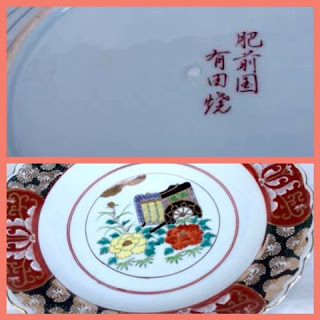Vocabulary when searching for Japanese Ceramics
*I will be adding to this list
Dating
(江戸) Edo Period (1603-1868)
(江戸前期) Early Edo period (roughly 1600's)
(江戸中期)Mid Edo period (roughly 1700's)
(元禄時代) Genroku Jidai (1688-1704) "The Golden Age"
(江戸後期)Late Edo period (roughly early to mid 1800's)
(天呆時代) Tenpo Jidai 1830-1844
(江戸幕末)Edo Bakumatsu period (1853-1867)
(明治前期 Early Meiji Period (1868-)
*decline in quality 1872-1881 export production increased 150 fold, world market collapse 1882
(明治後期~大正)Late Meiji ~Taisho period (1898~)
*increased development of mass production
(大正)Taisho period (1912-1926)
(戦前) Pre-war
(昭和戦前) Pre War Showa (1926- WWII)
*during the war only domestic production under government control
(昭和戦後) Post War Showa (1946-)
(昭和) Showa (1926-1989)
(現代) Gen Dai contemporary
Japanese Ceramic Export Eras
Here is a rough guideline for EXPORTS to the USA from Meiji period onwards:
1868-1890 either marked with Japanese characters or unmarked
1891-1921 Nippon, Made in Nippon
1921-1940 Made in Japan or Japan
1941-1945 WW II few, if any exports
1945-1952 Made in Occupied Japan
1953~ Japan, Made in Japan
Dai Nippon (大日本) "Great Japan" on many later Meiji, Taisho and even some Showa era exports.
Type of ceramics
上野焼 Agano Yaki
赤膚焼 Akahada Yaki
天草焼Amakusa Yaki
朝日焼 Asahi Yaki
有田焼 Arita Yaki
備前焼 Bizen Yaki
萩焼 Hagi Yaki
波佐見焼 Hasami Yaki
平戸焼 Hirado Yaki
一ノ瀬焼 Ichinose Yaki
伊賀焼 Iga Yaki
伊万里焼 Imari Yaki
犬山焼 Inuyama Yaki
出石焼 Izushi Yaki
唐津焼 Karatsu Yaki
笠間焼 Kasama Yaki
清水焼 Kiyomizu Yaki
高田焼 Koda Yaki
小石原焼 Koishiwara Yaki
古曽部焼 Kosobe Yaki
九谷焼 Kutani Yaki
京焼 Kyo-Yaki
益子焼 Mashiko Yaki
松代焼 Matsushiro Yaki
美濃焼 Mino Yaki
大堀相馬焼 Obori Soma Yaki
小鹿田焼 Onta Yaki
楽焼 Raku Yaki
薩摩焼 Satsuma Yaki
瀬戸焼 Seto Yaki
渋草焼 Shibakusa Yaki
信楽焼 Shigaraki Yaki
小代焼 Shodai Yaki
高取焼 Takatori Yaki
丹波焼 Tanba Yaki
砥部焼 Tobe Yaki
Chinese Markings on Japanese Ceramics
成化年製 Sei Ka Nen Sei
大明年製 Dai Min Nen Sei
太明年製 Tai Min Nen Sei
太明成化年製 Tai Min Sei Ka Nen Sei
大明萬暦年製 Dai Min Ban Reki Nen Sei
奇玉宝鼎之珍 Ki Gyoku Hou Tei No Chin
冨貴長春 Fu Ki Cho Shun
竒石寳鼎之珍 Ki Seki Ho Tei No Chin
太明清化年製 Tai Min Seika Nen Sei this may be an early “typo” for 太and 清
Helpful Search Phrases
アンティーク和食器 Antique Japanese dishes
陶器 Pottery
陶磁器 Porcelain
輸出陶器 Export Pottery
明治輸出陶 Meiji Export Pottery
昭和レトロ Showa Retro
染付けSometsuke (blue and white)
金襴手 Kinrante (Kin ran te)
カップ&ソーサー cup and saucer
蓋付き茶碗 Futatsuki Chawan or lidded bowl
窯 Kiln (reading can be kama, gama, yo)
窯印 Kamajirushi-kiln mark
瑠璃釉金彩 Azure blue glaze with gold
(墨弾) Sumihajiki is a resist method used to on ceramics to leave white areas when painted or glazed.
焼き締めYakishime is high-fired unglazed stoneware.
陶芸家Tougeika potter
市松模様 Ichimatsu Moyō/checkerboard motif
Made/produced/manufactured:
作 saku
造 Zo
製 Sei



























































